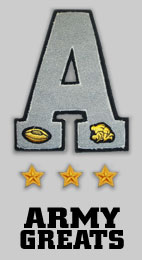
Home
Classes
Coaches
Army Greats
Army Lore
Teams
Of Interest...
About
Submissions
Contact
Newsletter
Credits
Click on small photos
 Cadet will not Lie, Cheat, Steal, or Tolerate Those Who Do Cadet will not Lie, Cheat, Steal, or Tolerate Those Who Do
 USMA at West Point USMA at West Point
 We have changed the wording of our Alma Mater to reflect the fact that our Women Graduates have also given their lives serving this Nation.
We have changed the wording of our Alma Mater to reflect the fact that our Women Graduates have also given their lives serving this Nation.
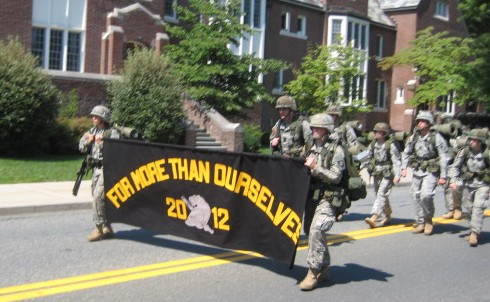 ----- Class of 2012 Motto ------ - "For More Than Ourselves" -Thank you Class of 2012 - for the Honor of Marching with you
The Class of 62 - Can Do ----- Class of 2012 Motto ------ - "For More Than Ourselves" -Thank you Class of 2012 - for the Honor of Marching with you
The Class of 62 - Can Do
 Remember - The Soldiers you will lead Always Come First Remember - The Soldiers you will lead Always Come First
 Motto -- Duty Honor Country Motto -- Duty Honor Country
 The Cadets of West Point
The Cadets of West Point
 They played perhaps Army's Greatest Game. They were the Team that Gave The Most They played perhaps Army's Greatest Game. They were the Team that Gave The Most
 Washington's Letter recommending the establishment of the Academy and the History of West Point
Washington's Letter recommending the establishment of the Academy and the History of West Point

The Oaths We Take
 West Point's Medal of Honor Recipients West Point's Medal of Honor Recipients
 Jefferson Hall - the Academy's new Library.
Jefferson Hall - the Academy's new Library.
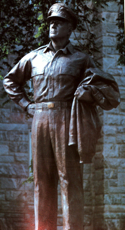 Douglas MacArthur
Douglas MacArthur
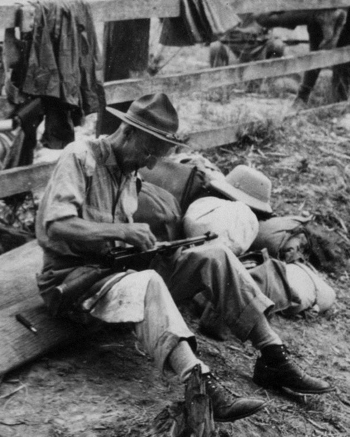
Vinegar Joe Stilwell cleaning his Thompson -The Walkout -Burma 1942
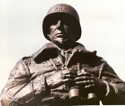 George Patton
George Patton
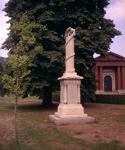 The Monuments of West Point
The Monuments of West Point
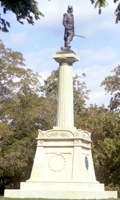 Kosciuszko Monument - Guarding the Hudson ensuring there is no passage of British Man of War
Kosciuszko Monument - Guarding the Hudson ensuring there is no passage of British Man of War
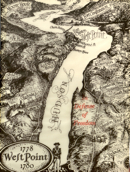 Forts of the Hudson
Forts of the Hudson
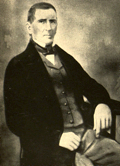
So we'll sing our reminiscences of Benny Havens, Oh!
 Academic Excellence Academic Excellence
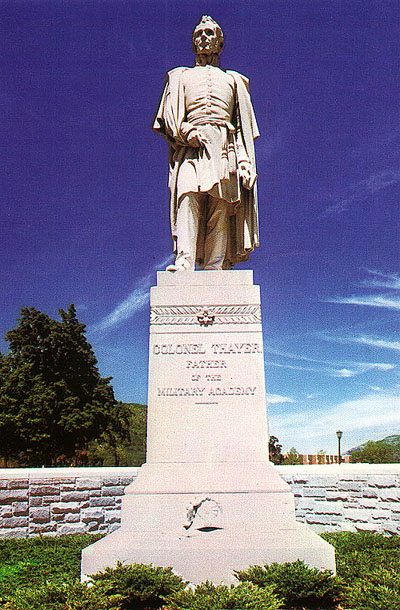 ---- Colonel Thayer ---- Colonel Thayer
 West Point West Point
 Trophy Point Trophy Point
 L'Ecole Polytechnique Monument, or The French Monument by Cadets L'Ecole Polytechnique Monument, or The French Monument by Cadets
 Superintendent's Quarters viewed from Thayer Road Superintendent's Quarters viewed from Thayer Road
 Superintendant was not Happy
Black '57
Superintendant was not Happy
Black '57
 Home of the Dean Home of the Dean
 Quarters 104 Quarters 104
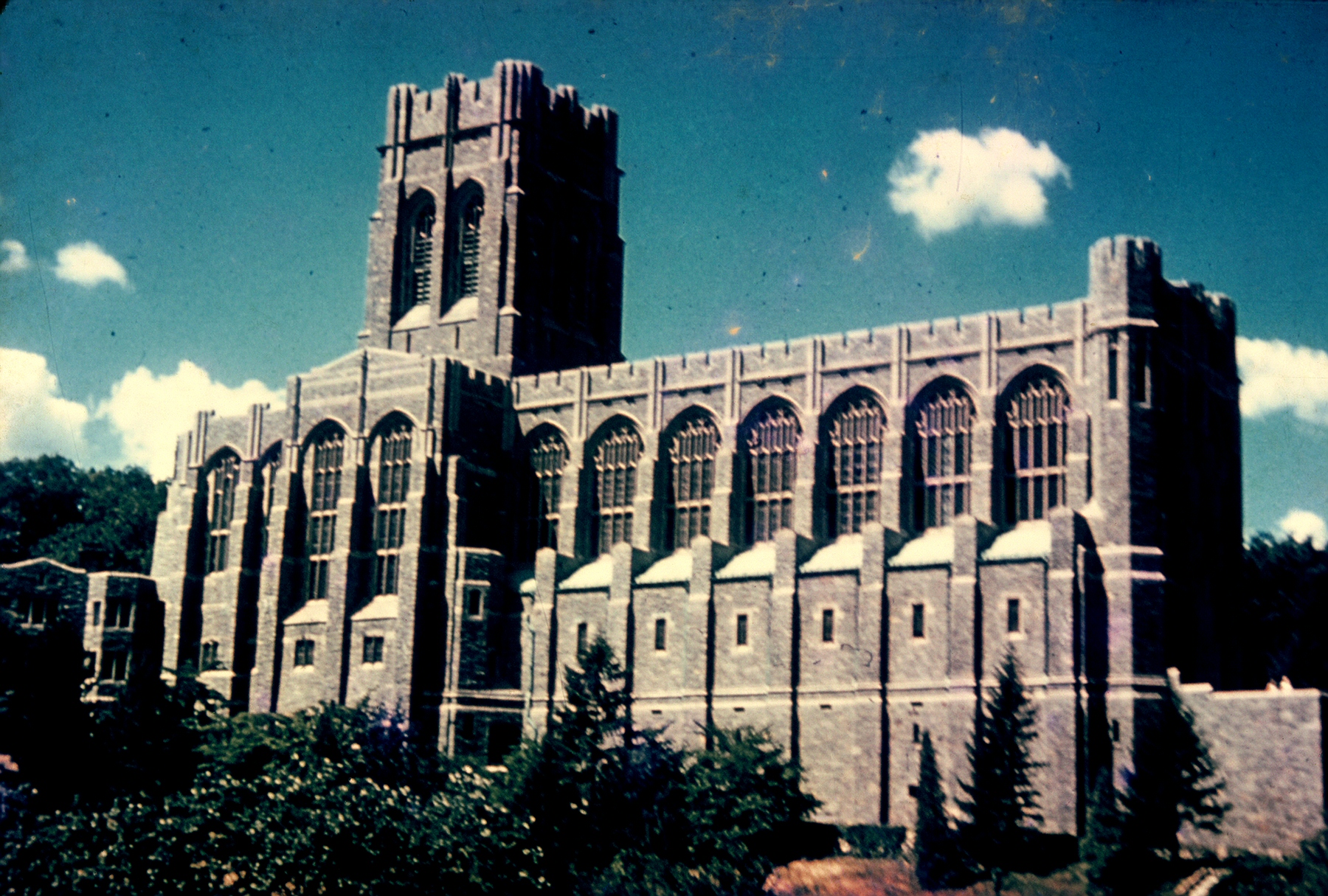 Cadet Chapel Cadet Chapel
 Michie Stadium Michie Stadium
 Arvin Gym Arvin Gym
 Kimsey Athletic Center Kimsey Athletic Center
 Holleder Center Holleder Center
 Washington Monument Washington Monument
 United States Military Academy Band United States Military Academy Band
 Cadet Barracks Cadet Barracks
 Rugby Complex Rugby Complex
 Great Chain Great Chain
 Plain looking toward Washington Hall Plain looking toward Washington Hall
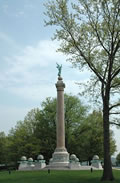 Battle Monument Battle Monument
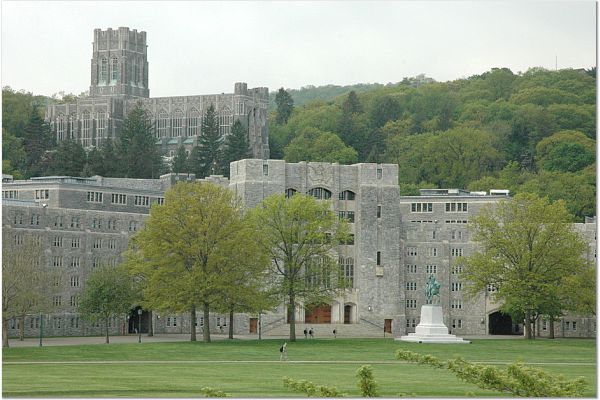 Washington Hall with Cadet Chapel on rocks above. Washington Hall with Cadet Chapel on rocks above.
 Hudson River Hudson River
 Captured Trophies Captured Trophies
 Battle Monument Battle Monument
 West Point Cemetery West Point Cemetery
 Plain Plain
 Cost to this Nation of Differing Views Cost to this Nation of Differing Views
 Trophy Point -- Our Flag Trophy Point -- Our Flag
 Corps of Cadets Formed in Companies early 1960s Corps of Cadets Formed in Companies early 1960s
 Corps of Cadets Formed in Companies early 1960s Corps of Cadets Formed in Companies early 1960s
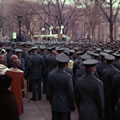 Sending the Army Team off to Beat Navy Sending the Army Team off to Beat Navy
 Army Mule Army Mule
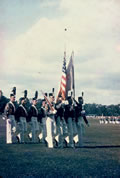 Color Guard Color Guard

Band Box Review Early 1950's in Central Area
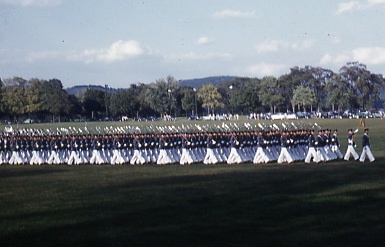 Battalion Mass Early 50's Battalion Mass Early 50's
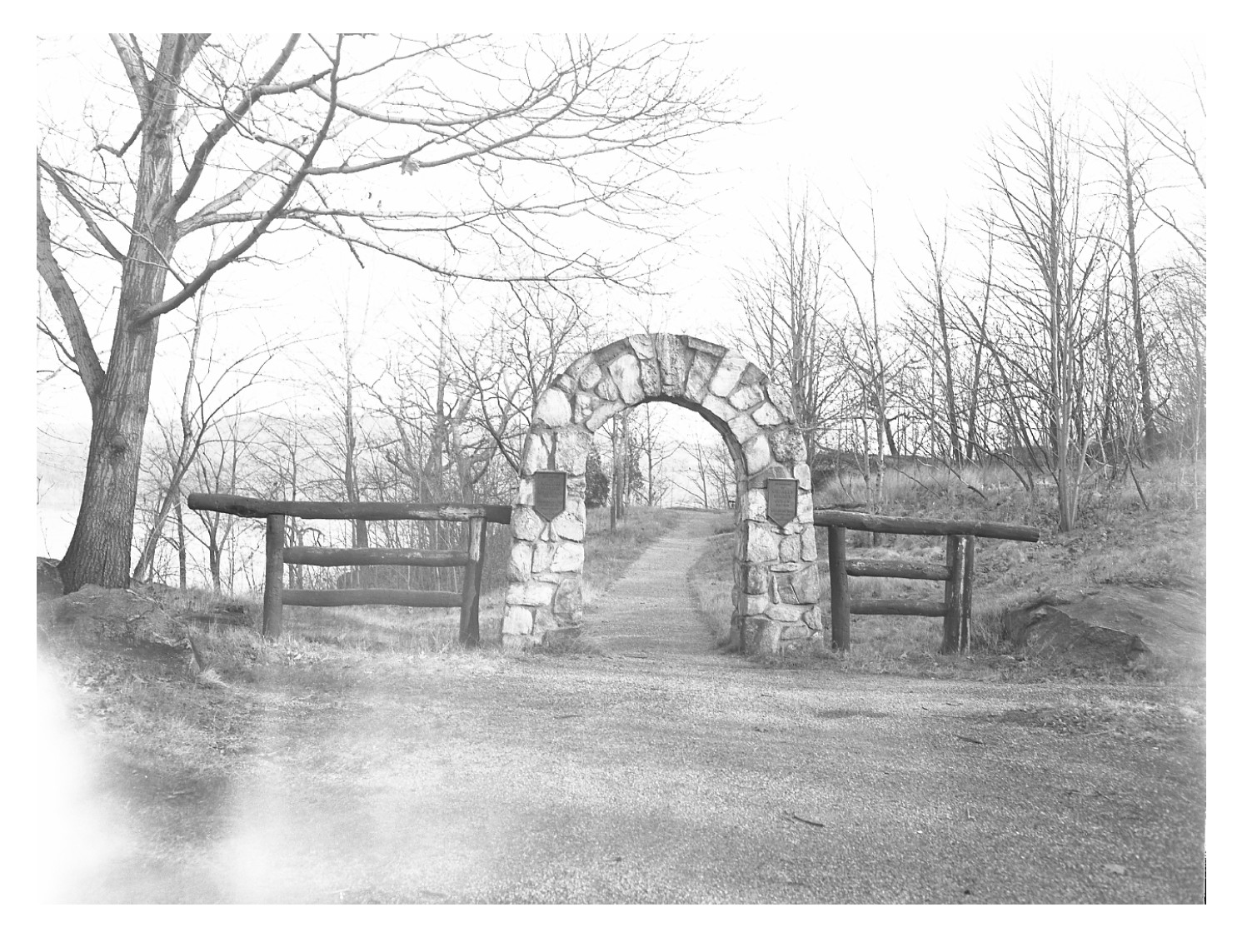 Flirtation Walk Flirtation Walk

 Arvin Gym Arvin Gym
Duty Honor Country
 Cadet will not Lie, Cheat, Steal, or Tolerate Those Who Do Cadet will not Lie, Cheat, Steal, or Tolerate Those Who Do
 Motto -- Duty Honor Country Motto -- Duty Honor Country
 Remember - The Soldiers you will lead Always Come First Remember - The Soldiers you will lead Always Come First

 Academic Excellence Academic Excellence
 --They played perhaps Army's Greatest Game. They were the Team that Gave The Most --They played perhaps Army's Greatest Game. They were the Team that Gave The Most
 Colonel Thayer Colonel Thayer
 West Point mid 60's West Point mid 60's
 Trophy Point Trophy Point
 L'Ecole Polytechnique Monument, or The French Monument by Cadets L'Ecole Polytechnique Monument, or The French Monument by Cadets
 Superintendent's Quarters viewed from Thayer Road Superintendent's Quarters viewed from Thayer Road
 Cadet Chapel Cadet Chapel
 Michie Stadium Michie Stadium
 Arvin Gym Arvin Gym
 Kimsey Athletic Center Kimsey Athletic Center
 Holleder Center Holleder Center
 Washington Monument Washington Monument
 United States Military Academy Band United States Military Academy Band
 Barracks Barracks
 Rugby Complex Rugby Complex
 Great Chain Great Chain
 Plain looking toward Washington Hall Plain looking toward Washington Hall
 Battle Monument Battle Monument
 Washington Hall with Cadet Chapel on rocks above. Washington Hall with Cadet Chapel on rocks above.
 Hudson River Hudson River
 Captured Trophies Captured Trophies
 Battle Monument Battle Monument
 West Point Cemetery West Point Cemetery
 Plain Plain
 Cost to this Nation of Differing Views Cost to this Nation of Differing Views
 Trophy Point -- Our Flag Trophy Point -- Our Flag
 Corps of Cadets Formed in Companies early 1960s Corps of Cadets Formed in Companies early 1960s
 Corps of Cadets Formed in Companies early 1960s Corps of Cadets Formed in Companies early 1960s
 Sending the Army Team off to Beat Navy Sending the Army Team off to Beat Navy
 Army Mule Army Mule
 Color Guard Color Guard

Band Box Review Early 1950's in Central Area
 Battalion Mass Early 50's Battalion Mass Early 50's
 Flirtation Walk Flirtation Walk
 Cadet will not Lie, Cheat, Steal, or Tolerate Those Who Do Cadet will not Lie, Cheat, Steal, or Tolerate Those Who Do
 Motto -- Duty Honor Country Motto -- Duty Honor Country
 Remember - The Soldiers you will lead Always Come First Remember - The Soldiers you will lead Always Come First
 Academic Excellence Academic Excellence
 They played perhaps Army's Greatest Game. They were the Team that Gave The Most They played perhaps Army's Greatest Game. They were the Team that Gave The Most
 Colonel Thayer Colonel Thayer
 West Point mid 60's West Point mid 60's
 Trophy Point Trophy Point
 L'Ecole Polytechnique Monument, or The French Monument by Cadets L'Ecole Polytechnique Monument, or The French Monument by Cadets
 Superintendent's Quarters viewed from Thayer Road Superintendent's Quarters viewed from Thayer Road
 Cadet Chapel Cadet Chapel
 Michie Stadium Michie Stadium
 Arvin Gym Arvin Gym
 Kimsey Athletic Center Kimsey Athletic Center
 Holleder Center Holleder Center
 Washington Monument Washington Monument
 United States Military Academy Band United States Military Academy Band
 Barracks Barracks
 Rugby Complex Rugby Complex
 Great Chain Great Chain
 Plain looking toward Washington Hall Plain looking toward Washington Hall
 Battle Monument Battle Monument
 Washington Hall with Cadet Chapel on rocks above. Washington Hall with Cadet Chapel on rocks above.
 Hudson River Hudson River
 Captured Trophies Captured Trophies
 Battle Monument Battle Monument
 West Point Cemetery West Point Cemetery
 Plain Plain
 - Cost to this Nation of Differing Views - Cost to this Nation of Differing Views
 Trophy Point -- Our Flag Trophy Point -- Our Flag
 Corps of Cadets Formed in Companies early 1960s Corps of Cadets Formed in Companies early 1960s
 Corps of Cadets Formed in Companies early 1960s Corps of Cadets Formed in Companies early 1960s
 Sending the Army Team off to Beat Navy Sending the Army Team off to Beat Navy
 - Army Mule - Army Mule
 Color Guard Color Guard

Band Box Review Early 1950's in Central Area
 Battalion Mass Early 50's Battalion Mass Early 50's
 Flirtation Walk Flirtation Walk
Click on Photos Below
Please note it takes a couple of hours to update all pages as material is added to this section. You may have to return to the home page to see all of the current links
 Cadet will not Lie, Cheat, Steal, or Tolerate Those Who Do Cadet will not Lie, Cheat, Steal, or Tolerate Those Who Do
 We have changed the wording of our Alma Mater to reflect the fact that our Women Graduates have also given their lives serving this Nation.
We have changed the wording of our Alma Mater to reflect the fact that our Women Graduates have also given their lives serving this Nation.
 ----- Class of 2012 Motto ----- "For More Than Ourselves" Thank you Class of 2012 for the Honor of Marching with you
The Class of 62 ----- Class of 2012 Motto ----- "For More Than Ourselves" Thank you Class of 2012 for the Honor of Marching with you
The Class of 62
 ---------- Class of 2008 --------- ----- Class Crest & Motto ----- "No Mission Too Great" ---------- Class of 2008 --------- ----- Class Crest & Motto ----- "No Mission Too Great"
---- Their Commencement ---- "Here am I; Send me." Thank you Class of 2008 and Please Thank the Men & Women --- the Soldiers you will lead ---
The Class of 62.
 Motto -- Duty Honor Country Motto -- Duty Honor Country
 Remember - The Soldiers you will lead Always Come First Remember - The Soldiers you will lead Always Come First
 Jefferson Hall - the Academy's new Library.
Jefferson Hall - the Academy's new Library.
 Academic Excellence Academic Excellence
 --They played perhaps Army's Greatest Game. They were the Team that Gave The Most --They played perhaps Army's Greatest Game. They were the Team that Gave The Most
 ---- Colonel Thayer ---- Colonel Thayer
 West Point mid 60's West Point mid 60's
 Trophy Point Trophy Point
 L'Ecole Polytechnique Monument, or The French Monument by Cadets L'Ecole Polytechnique Monument, or The French Monument by Cadets
 Superintendent's Quarters viewed from Thayer Road Superintendent's Quarters viewed from Thayer Road
 Cadet Chapel Cadet Chapel
 Michie Stadium Michie Stadium
 Arvin Gym Arvin Gym
 Kimsey Athletic Center Kimsey Athletic Center
 Holleder Center Holleder Center
 Washington Monument Washington Monument
 United States Military Academy Band United States Military Academy Band
 Barracks Barracks
 Rugby Complex Rugby Complex
 Great Chain Great Chain
 Plain looking toward Washington Hall Plain looking toward Washington Hall
 Battle Monument Battle Monument
 Washington Hall with Cadet Chapel on rocks above. Washington Hall with Cadet Chapel on rocks above.
 Hudson River Hudson River
 Captured Trophies Captured Trophies
 Battle Monument Battle Monument
 West Point Cemetery West Point Cemetery
 Plain Plain
 - Cost to this Nation of Differing Views - Cost to this Nation of Differing Views
 Trophy Point -- Our Flag Trophy Point -- Our Flag
 Corps of Cadets Formed in Companies early 1960s Corps of Cadets Formed in Companies early 1960s
 Corps of Cadets Formed in Companies early 1960s Corps of Cadets Formed in Companies early 1960s
 Sending the Army Team off to Beat Navy Sending the Army Team off to Beat Navy
 - Army Mule - Army Mule
 Color Guard Color Guard

Band Box Review Early 1950's in Central Area
 Battalion Mass Early 50's Battalion Mass Early 50's
 Flirtation Walk Flirtation Walk

 Arvin Gym Arvin Gym
Duty Honor Country
 Cadet will not Lie, Cheat, Steal, or Tolerate Those Who Do Cadet will not Lie, Cheat, Steal, or Tolerate Those Who Do
 Motto -- Duty Honor Country Motto -- Duty Honor Country
 Remember - The Soldiers you will lead Always Come First Remember - The Soldiers you will lead Always Come First

 Academic Excellence Academic Excellence
 --They played perhaps Army's Greatest Game. They were the Team that Gave The Most --They played perhaps Army's Greatest Game. They were the Team that Gave The Most
 ---- Colonel Thayer ---- Colonel Thayer
 West Point mid 60's West Point mid 60's
 Trophy Point Trophy Point
 L'Ecole Polytechnique Monument, or The French Monument by Cadets L'Ecole Polytechnique Monument, or The French Monument by Cadets
 Superintendent's Quarters viewed from Thayer Road Superintendent's Quarters viewed from Thayer Road
 Cadet Chapel Cadet Chapel
 Michie Stadium Michie Stadium
 Arvin Gym Arvin Gym
 Kimsey Athletic Center Kimsey Athletic Center
 Holleder Center Holleder Center
 Washington Monument Washington Monument
 United States Military Academy Band United States Military Academy Band
 Barracks Barracks
 Rugby Complex Rugby Complex
 Great Chain Great Chain
 Plain looking toward Washington Hall Plain looking toward Washington Hall
 Battle Monument Battle Monument
 Washington Hall with Cadet Chapel on rocks above. Washington Hall with Cadet Chapel on rocks above.
 Hudson River Hudson River
 Captured Trophies Captured Trophies
 Battle Monument Battle Monument
 West Point Cemetery West Point Cemetery
 Plain Plain
 - Cost to this Nation of Differing Views - Cost to this Nation of Differing Views
 Trophy Point -- Our Flag Trophy Point -- Our Flag
 Corps of Cadets Formed in Companies early 1960s Corps of Cadets Formed in Companies early 1960s
 Corps of Cadets Formed in Companies early 1960s Corps of Cadets Formed in Companies early 1960s
 Sending the Army Team off to Beat Navy Sending the Army Team off to Beat Navy
 - Army Mule - Army Mule
 Color Guard Color Guard

Band Box Review Early 1950's in Central Area
 Battalion Mass Early 50's Battalion Mass Early 50's
 Flirtation Walk Flirtation Walk
 Cadet will not Lie, Cheat, Steal, or Tolerate Those Who Do Cadet will not Lie, Cheat, Steal, or Tolerate Those Who Do
 Motto -- Duty Honor Country Motto -- Duty Honor Country
 Remember - The Soldiers you will lead Always Come First Remember - The Soldiers you will lead Always Come First
 Academic Excellence Academic Excellence
 --They played perhaps Army's Greatest Game. They were the Team that Gave The Most --They played perhaps Army's Greatest Game. They were the Team that Gave The Most
 ---- Colonel Thayer ---- Colonel Thayer
 West Point mid 60's West Point mid 60's
 Trophy Point Trophy Point
 L'Ecole Polytechnique Monument, or The French Monument by Cadets L'Ecole Polytechnique Monument, or The French Monument by Cadets
 Superintendent's Quarters viewed from Thayer Road Superintendent's Quarters viewed from Thayer Road
 Cadet Chapel Cadet Chapel
 Michie Stadium Michie Stadium
 Arvin Gym Arvin Gym
 Kimsey Athletic Center Kimsey Athletic Center
 Holleder Center Holleder Center
 Washington Monument Washington Monument
The material below this point is a site a work area.


Page 2
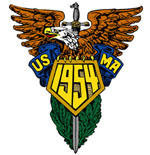 The '54 Crest
The '54 Crest
 General MacArthur stated it would take
General MacArthur stated it would take "at least 10 years" to return Army Football to Respectability
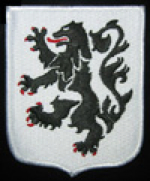 28th Infantry Regiment Black Lion Award is intended to go to the person on his team "who best exemplifies the character of Don Holleder: leadership, courage, devotion to duty, self-sacrifice, and - above all -
28th Infantry Regiment Black Lion Award is intended to go to the person on his team "who best exemplifies the character of Don Holleder: leadership, courage, devotion to duty, self-sacrifice, and - above all - an unselfish concern for the team ahead of himself."
 General George Patton
General George Patton "The Army moves as a team, eats as a team, and fights as a team."
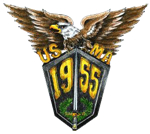 The '55 Crest
The '55 Crest
 They played perhaps Army's Greatest Game. They played perhaps Army's Greatest Game.They were the Team that Gave The Most
 Don Holleder Remember - The Soldiers you will lead Always Come First
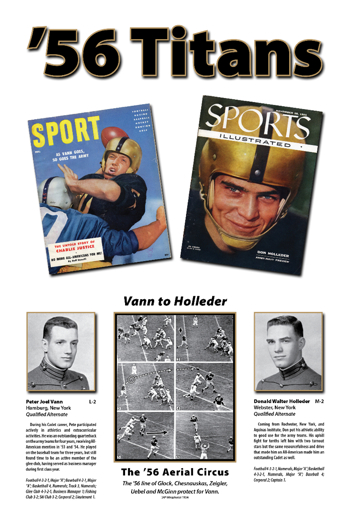 Vann and Holleder Vann and Holleder
 9 Army A's 9 Army A's
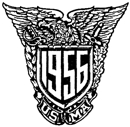 The '56 Crest
The '56 Crest
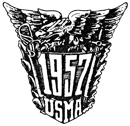 The '57 Crest
The '57 Crest
 Can Do
Can Do
 Gen Van Fleet addressing the Corps prior to the Navy Game
Gen Van Fleet addressing the Corps prior to the Navy Game
 Constructed under supervision of Jay Gould "54 and the Ord Dept from a German Rocket Gun captured at Kasserine Pass. First used in the Duke Game.
Constructed under supervision of Jay Gould "54 and the Ord Dept from a German Rocket Gun captured at Kasserine Pass. First used in the Duke Game.
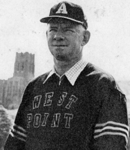 COL "Red" Reeder granted the Cheerleaders Corps Squad status to obtain financial support for their spirit-inducing initiatives.
COL "Red" Reeder granted the Cheerleaders Corps Squad status to obtain financial support for their spirit-inducing initiatives.
 Bob Mischak - - It should be pointed out that Bob was an All American selection, but is not recognized by the Academy as such because of the organization which selected him. Bob Mischak - - It should be pointed out that Bob was an All American selection, but is not recognized by the Academy as such because of the organization which selected him.
 Ubel scores 3 Times against Navy - Vann's facking results in Peter getting tackled - #10 on the ground behind Ubel
Ubel scores 3 Times against Navy - Vann's facking results in Peter getting tackled - #10 on the ground behind Ubel
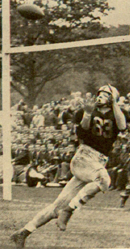 Vann to Sisson
Vann to Sisson
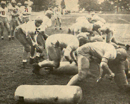 Army's B Squad
Army's B Squad
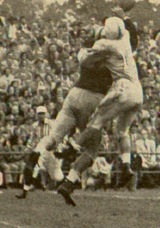 Vann to Mischak. Vann to Mischak.
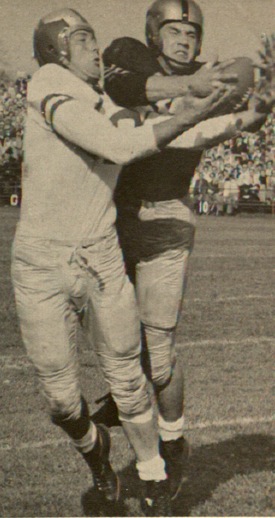 Uebel Intercepts Uebel Intercepts
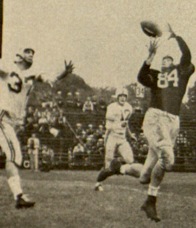 Cody to Don Holleder Cody to Don Holleder
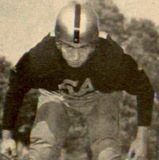 Lasley Lasley
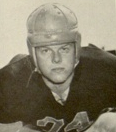 Frank Hicks Frank Hicks
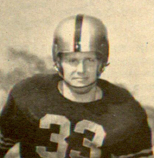 Burd Burd
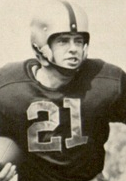 Bill Purdue Bill Purdue
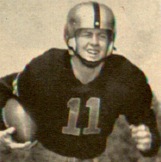 Cody Cody
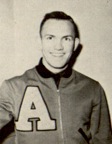 Meador Mgr Meador Mgr
 Ron Melnick Ron Melnick
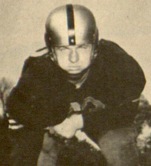 Ralph Chesnauskas Ralph Chesnauskas
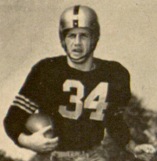 Pat Uebel Pat Uebel
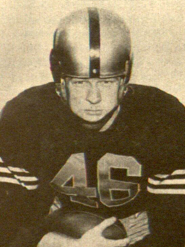 Tommy Bell Tommy Bell
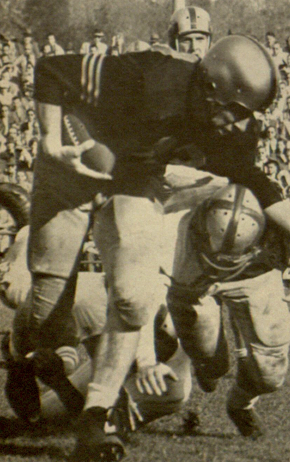 Sisson headed for another score Sisson headed for another score
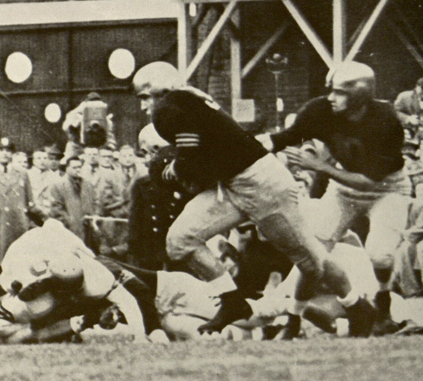 Peter Vann stuffs the ball in Jerry's gut Peter Vann stuffs the ball in Jerry's gut
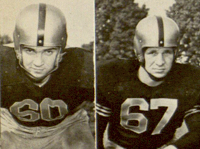 Leroy Lunn & Jerry Lodge Leroy Lunn & Jerry Lodge
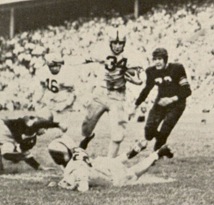 Uebel after taking the handoff from Hagan
Uebel after taking the handoff from Hagan
 Attaya - Army's Fullback
Attaya - Army's Fullback
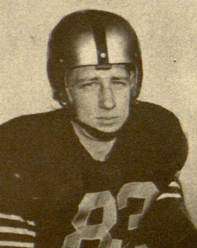 Sisson - one of 3 Great Ends
Sisson - one of 3 Great Ends
 Bob Mischak Bob Mischak
 Ralph Chesnauskas Ralph Chesnauskas
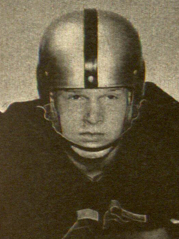 Bob Farris Bob Farris
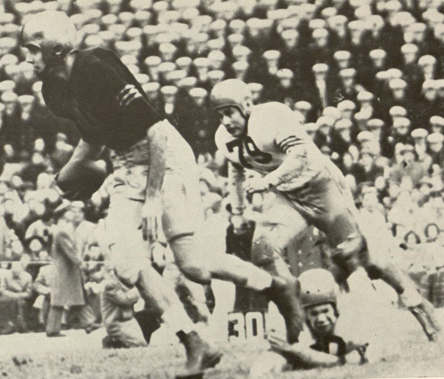 Vann moving out of the pocket
Vann moving out of the pocket
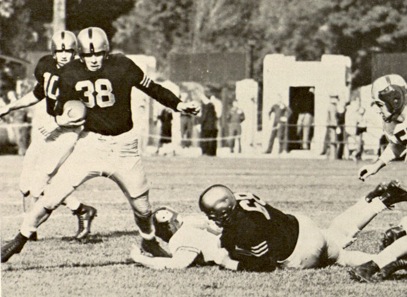 Peter Vann 10, Billy Chance 38, Herdman 68
Peter Vann 10, Billy Chance 38, Herdman 68
 Ken Kramer Ken Kramer
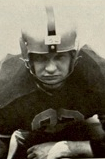 Joe Lapchick Joe Lapchick
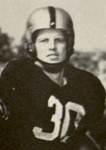 Kirk Cockrell Kirk Cockrell
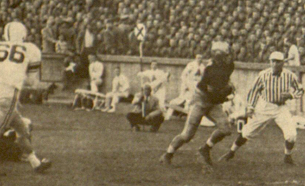 Lodge going down tosses to Paul Schweikert for score. Lodge going down tosses to Paul Schweikert for score.
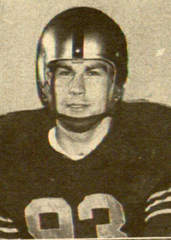 Dick Zeigler Dick Zeigler
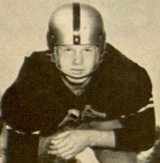 Bob FarrisPlayed the 2d half of the Navy Game blind in one eye. Bob FarrisPlayed the 2d half of the Navy Game blind in one eye.
 Pat Uebel Pat Uebel
 Tommy Bell Tommy Bell
 Peter Vann Peter Vann
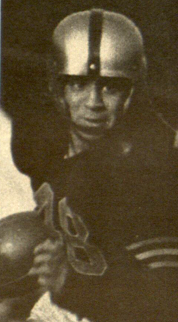 Freddie Attaya Freddie Attaya
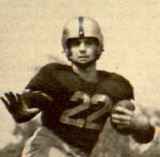 Mike Zeigler Mike Zeigler
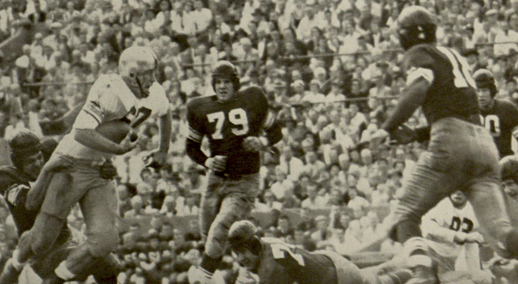 Jerry Lodge wearing #67, playing fullback. Jerry Lodge wearing #67, playing fullback.
 Johnny Wing Johnny Wing
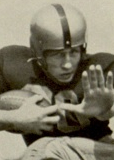 Lowell Sisson Lowell Sisson
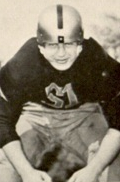 Norm Stephen Norm Stephen
 Jack Krause Jack Krause
 Dick Ziegler Dick Ziegler
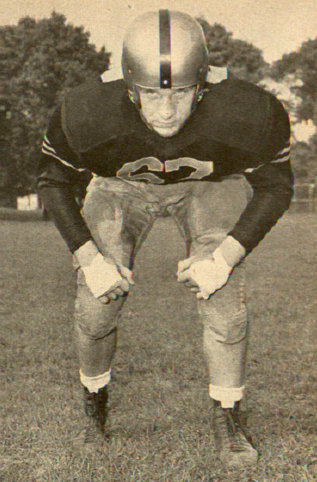 Jerry Lodge Jerry Lodge
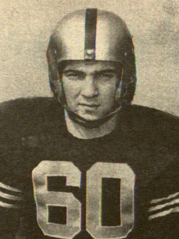 Leroy Lunn Leroy Lunn
 Norm Stephen Norm Stephen
 Jerry Lodge Jerry Lodge
 Corps of Cadets for Navy Game Corps of Cadets for Navy Game
 Can Do
Can Do
 General MacArthur stated it would take
General MacArthur stated it would take "at least 10 years" to return Army Football to Respectability
 General George Patton
General George Patton "The Army moves as a team, eats as a team, and fights as a team."
 Don Holleder Remember - The Soldiers you will lead Always Come First
 The '54 Crest
The '54 Crest
 The '55 Crest
The '55 Crest
 28th Infantry Regiment Black Lion Award is intended to go to the person on his team "who best exemplifies the character of Don Holleder: leadership, courage, devotion to duty, self-sacrifice, and - above all -
28th Infantry Regiment Black Lion Award is intended to go to the person on his team "who best exemplifies the character of Don Holleder: leadership, courage, devotion to duty, self-sacrifice, and - above all - an unselfish concern for the team ahead of himself."
 They played perhaps Army's Greatest Game. They played perhaps Army's Greatest Game.They were the Team that Gave The Most
 The '56 Crest
The '56 Crest
 The '57 Crest
The '57 Crest
|
1926 Football Team
1926 Army 7-1-1 #8*
1926/11/27 Army 21 - Navy 21 T (Soldier Field, Chicago Il)
read below - THE GREATEST ARMY--NAVY
By Ray Schmidt
"...No single game in college football history has ever so completely
combined the color, spectacle, national media coverage, public popularity,
and top-flight level of play as the Army-Navy battle of 1926 at Soldier Field.
Robert Kelley of the New York Times defined the game's significance when he wrote
that day:
"Football had the greatest pageant, its high spot of color, and so did sport in the United States."
www.la84.org/SportsLibrary/CFHSN/CFHSNv17/CFHSNv17n2e.pdf
*"The 1926 college football season was the first to attempt recognition of a national champion.
The Dickinson System was a mathematical point formula that awarded national championships in college football.
Devised by University of Illinois economics professor Frank G. Dickinson, the system crowned national champions from 1926 to 1940,
and included predated rankings for 1924 and 1925."
Coach: Lawrence McCeney "Biff" Jones (October 8, 1895 - February 12, 1980)
Army 1926-1929 - 30-8-2
LSU 1932-1934 - 20-5-6
Oklahoma 1935-1936 - 9-6-3
Nebraska 1937-1941 - 28-14-4 (1940 Rose Bowl vs Stanford AP#7)
Total: 87-33-15
source: http://en.wikipedia.org/wiki/Biff_Jones

ArmyFB_1926_vsNavy_NewburghNews_Nov271926-1
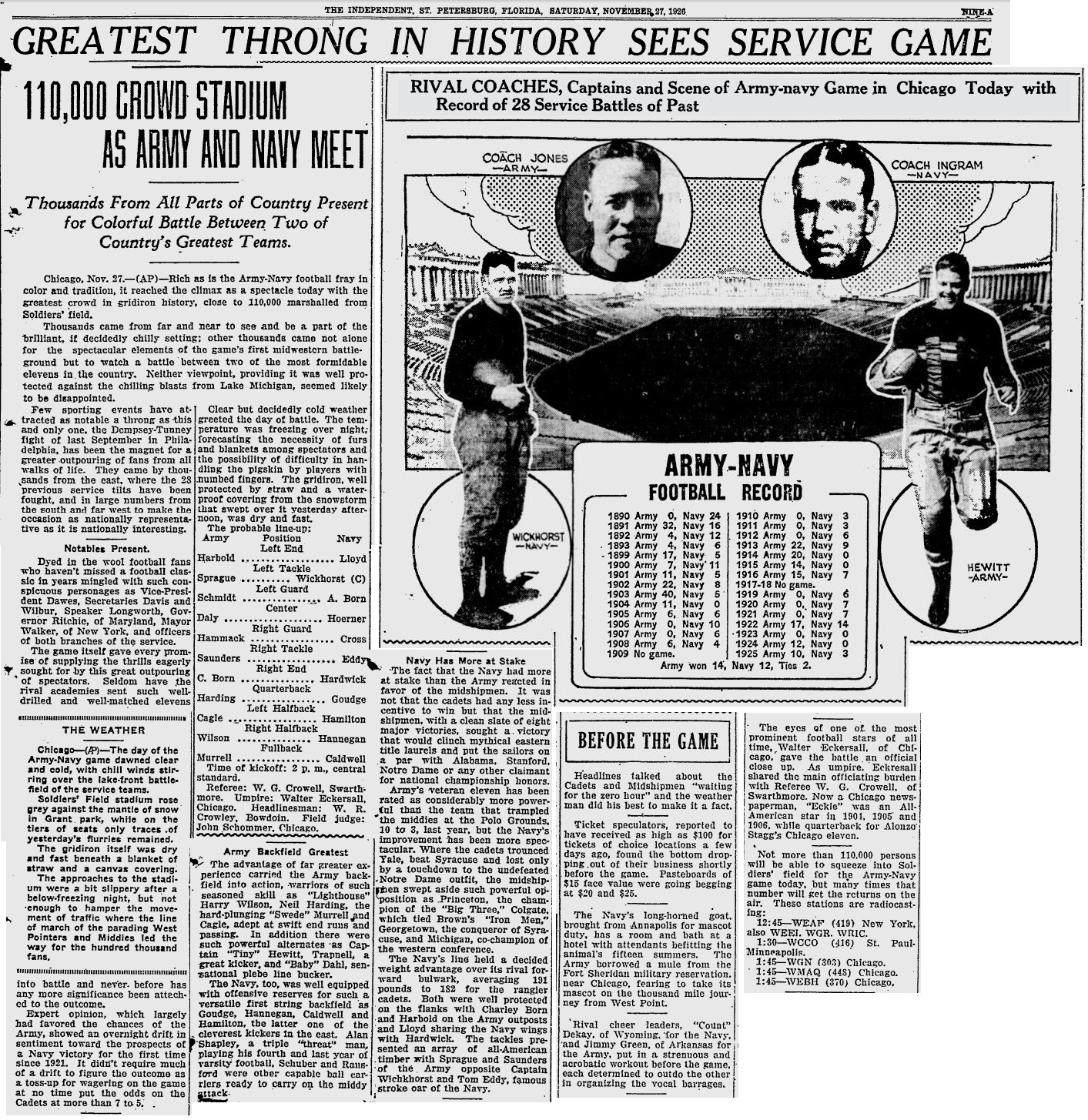
ArmyFB_1926_vsNavy_EveningIndependent_Nov271926

ArmyFB_1926_vsNavy_SarasotaHeraldTribune_Nov281926
THE GREATEST ARMY--NAVY
By Ray Schmidt
PAGE 9
There was a time -- more difficult to remember with each passing season -- when the results of the annual gridiron showdown between the teams of West Point and Annapolis (that's Army and Navy) were followed by football fans across the country, and often carried significance in the race for mythical national honors. Yet even more so, the game and its surrounding pageantry represented the best moments of college football. No other rivalry in college football consistently created such anticipation at the host cities, and then actually came through with the color, the excitement, and the spectacle that was unmatched -- with even a good football game on occasion.
From this long-running series there is one game that stands above the others as the greatest Army-Navy clash ever, and one of the best in the annals of all college football history. In the early 1940s, Esquire magazine conducted a poll and named the game "the greatest in history" to that time, while the long-time prominent coach, Clark Shaughnessy, selected it as one of the 12 greatest games of all-time. Shaughnessy described it as one game "seldom matched for brilliant and courageous individual play, and for daring and spectacular team strategy." It was of course the legendary 1926 Army-Navy showdown.
In those times the service academies alternated years in selecting the site for their annual game,and during the 1920s bids were frequently received from several cities -- usually always along the Eastern Seaboard. In late 1924, a group from Chicago -- supported by U.S. Representatives Fred Britten and Martin Madden of Illinois -- entered the bidding to host the 1925 Army-Navy game. The other cities seeking the game included Washington D.C., Philadelphia, Baltimore, and two different groups from New York (one representing the Polo Grounds and the other the relatively new Yankee Stadium). Chicago was under a handicap because of its distance from the two schools, and West Point officials (who would be selecting the 1925 site) were on record as opposing any site that would keep the Corps of Cadets away from the school overnight -- a position endorsed by War Secretary John W. Weeks.
The 1925 game was ultimately awarded to the Polo Grounds -- despite Yankee Stadium's larger seating capacity -- but Chicago businessmen were soon preparing another bid for the 1926 game which would be selected by Naval Academy officials. Again the Midwest city was challenged by New York, Baltimore, and Philadelphia, but this time it was better prepared The Chicago group announced its willingness to raise $100,000 for each academies' athletic fund, in addition
to the approximately $600,000 which would be required to cover the expenses of bringing the teams and students to the game. Yet the Eastern cities continued in the role of the favorites.
Political pressure upon the academies intensified, as Midwest congressmen and service men's organizations turned up the heat. No stone was left unturned -- in December 1925 the Chicago Herald-Examiner ran an editorial stating that an Army-Navy game in Chicago would "arouse in youthful civilian minds a new understanding of love of country and eager appreciation of what education at West Point and Annapolis means" -- this at a time when many leaders of America were urging the need for much better preparedness and training for the nation's youth, given the recent experiences of World War I. In case patriotism didn't strike the right chord, the editorial declared that, "Those great schools are not the exclusive property of the East."
In the end, political pressure and big money carried the day -- along with a stadium that could seat in excess of 100,000 ticket-buying fans -- and so Annapolis officials awarded the 1926 game to Chicago. The Midwest city had built mammoth Grant Park Stadium on the banks of Lake Michigan just south of the downtown area in 1925. Some football games had been played there that first season -- including Northwestern's famous 3-2 win over Michigan in the mud -- yet for 1926 the stadium was being renamed as "Soldier Field" in memory of World War I military personnel, and the Army-Navy game was selected as the formal dedication event.
Soldier Field was a U-shaped arena with a seating capacity of nearly 100,000, with many of the seats at the north end well beyond the gridiron itself. In anticipation of a large ticket demand for the Army-Navy clash, the Chicago Park Board was having temporary bleachers installed to close the open north end of the stadium -- with no concern that these seats would be 30-40 yards beyond the goal posts. After holding out the seats for the two visiting student bodies and numerous dignitaries, there remained 40,000 decent seats which were priced at either $15 or $10 each, with the binocular-type seats priced lower. A full house scaled at these prices would produce gate receipts of approximately $800,000.
To say the least, the demand for tickets was overwhelming, as over 600,000 ticket requests were received for the 100,000 seats available on sale. Placed in charge of the ticket sales was Colonel H.C. Carbaugh -- a 65-year old Army veteran who normally served as supervisor of the Civil Service Department for Chicago's South Park Board Members of the public seeking tickets at times became so aggressive that it was necessary for Carbaugh to have body guards while at work, and police were assigned to protect the entrances to the Park's Administration Building.
Of course it wouldn't be Chicago without some hint of corruption, and it came to light when U.S. Representative John J. Gorman from Chicago charged that the South Park Board was violating an earlier agreement with the Chicago-area congressmen by only providing them with a hundred tickets each. Gorman added that rumors abounded that each of the park commissioners was receiving 1200 tickets. E. J. Kelly, president of the South Park commissioners, replied that everything possible was being done to distribute the tickets fairly and no attention was being given to the complaints of the congressmen.
Two days before the game Navy's traveling party arrived aboard a special train via the Pennsylvania Railroad Coach Bill Ingram spurned a practice session at Soldier Field, and instead took his Middies to a workout on a secluded grassy island in the Sherman Park lagoon while guards protected all the bridgeways leading over the water. The Army team arrived soon afterward on the Michigan Central line, and Coach Biff Jones then drilled his charges at Soldier Field before the team headed for its accommodations at the South Shore Country Club.
The day before the game the visiting student bodies from the two academies were treated to a luncheon at Marshall Field's giant department store in downtown Chicago, after which the cadets and midshipmen staged a big parade south on Michigan Avenue as they marched to Soldier Field for the formal dedication ceremony. Meanwhile, there was also a full slate of luncheons and parties planned to entertain the service personnel throughout the weekend.
Helping to fuel the already overheated college football fans of Chicago was the fact that the two teams were among the nation's elite for 1926 -- Navy coming in with a record of 9-0-0 and Army at 7-1-0, with only a narrow 7-0 defeat to Notre Dame marring the Cadets record. The Army team was slightly favored, and its powerhouse included such great players as Chris Cagle, "Lighthorse" Harry Wilson, Chuck Born, Gar Davidson, and Red Murrell; while Navy countered with standouts such as Tom Hamilton, Frank Wickhorst, Tom Eddy, and Whitey Lloyd.
When time for the kickoff finally arrived on November 27, 1926 -- amidst concerns over the many counterfeit tickets which had been found in circulation -- Soldier Field was jammed with approximately 110,000 fans, with thousands more standing atop every nearby building, water tower, and bridge that afforded any hopes of a glimpse of the action. A New York Times writer surveyed the scene from the rim of Soldier Field and reported that, "Looking off over the top of the stadium, there was nothing to see but people." It was later stated that over 18,000 automobiles had been parked around the stadium, while Chicago taxi companies reported that they had made approximately 20,000 separate trips out to the arena. The massive crush of people and cars required the city to assign 1,350 police officers to direct traffic and maintain order. James Bennett of the Chicago Tribune described it as "a multitude that was worthy of the game."
It was a cold day along the Chicago lakefront, and, except for the sun breaking through on one occasion, the game was played under a gray and heavily clouded sky. Snow banks surrounded the field from an earlier storm that had required 300 men to work the entire night before the game shoveling off the seats of the stadium. Around the rim of the stadium were large American flags which rippled in the wintry breezes off Lake Michigan.
Army kicked off to open the game, and surprisingly, Coach Jones of the Cadets had a half dozen of his first string players on the sideline. After the teams exchanged punts, the offensive fireworks began. Starting from its 45 yard line, Navy began to mix an array of short passes with its running attack. After several plays moved the ball to Army's 34, Jim Schuber of Navy faked an end sweep but instead rifled a long pass that Hank Hardwick plucked out of the air at the eight yard line before being dragged down at the one. Two plays later Howard Caldwell blasted in for the touchdown, and Tom Hamilton's drop-kick made it 7-0, Navy.
Again the teams returned to an exchange of possessions although Navy clearly held the upper hand, and writer Walter Eckersall later declared that "the Middies appeared unbeatable in the first quarter." Late in the period Navy began a drive from its 43 yard line and, after a penalty set them back to the 32, Hamilton connected on a pass to Schuber that was good for 23 yards. After a couple more plays, Coach Jones rushed the rest of his Army first string into the game just before the quarter ended with the Middies at the Army 22. Several plays later Schuber blasted in from one yard out for the TD, and Hamilton's PAT made it 14-0.
Later in the second quarter Army finally got its offense on track behind the hard running of Chris Cagle and Harry Wilson. Starting from their 37 yard line after a punt, the Cadets got rolling as Wilson broke off a dazzling change of pace run of 23 yards to the Navy 40. Two playslater Cagle swept around right end on a 21-yard gallop, and on the next snap Wilson slashed through the left side of the line and sailed 17 yards to Army's first touchdown. Wilson's placekick made it 14-7.
The next time Army had the ball it was unable to move, and so Red Murrell dropped back to his 20, from where he boomed a towering punt that came down to the Middies' Howard Ransford on the Navy 25. Attempting a running catch, Ransford fumbled the ball and the bouncing pigskin caromed off the foot of Army's Skip Harbold and toward the Navy goal line. Catching up with the ball near the 15, Harbold picked it up and rumbled toward paydirt, and despite falling down at the one, the weary cadet managed to squirm into the end zone for the touchdown. Wilson's PAT made it 14-14, and the wild first half soon came to a close.
After the gigantic throng had been entertained by a mock battle between students of the two schools, the second half got underway as Army started from its 26 after Cagle's 20-yard runback of the kickoff. Several plays later Wilson swept around left end for a gain of 15 yards to the Navy 44, and on the next snap Cagle broke up the middle and dashed all the way for the touchdown that put Army ahead 21-14 after Wilson's PAT.
Despite the stunning comeback by the Cadets, the Middies returned to the attack. Both of the high-powered offenses fought back and forth until late in the third quarter when Navy started from its 43 yard line after a punt. Slowly the Middies headed up the field as the action moved into the fourth quarter. Hamilton completed two key passes to Alan Shapley on the drive, and Ransford chipped in a critical gain of eight yards for a first down at Army's 15. The 12-play drive was capped off in sensational fashion when Shapley swept around right end on a fourth down and three play for an eight-yard touchdown run. With the entire stadium holding its breath, Hamilton calmly drop-kicked the extra point to tie it at 21-21.
With just over seven minutes left to play, the surrounding gloom and darkness had gathered to the point where it was increasingly difficult for fans and writers in the press box to distinguish the players on the field. Still, Army mounted one last attempt at the win, starting from its 27 yard line after the following kickoff. On the second play of the series Wilson broke through left tackle for a 28 yard dash into Navy territory, and then he and Murrell alternated in pounding the Middies' line. Finally, checked just inside the 20, Wilson dropped back to attempt a place-kick from the 26. The ball was spotted directly in front of the goal posts, but incredibly Wilson's kick sailed just wide.
The final couple minutes were played in "almost total darkness," as the electric lights over the stadium's entrance tunnels and on the Scoreboard twinkled in the gloom. On the last play of the game Hamilton attempted a desperate pass for Navy, but the aerial was intercepted by (and here's where the darkness contributed to the confusion) either Wilson, Cagle, or Chuck Harding -- depending on which game account you choose to accept. The runback was finally halted deep in Navy territory, and so the monumental battle ended in a 21-21 tie.
Combined with Notre Dame's shocking 19-0 loss to Carnegie Tech that same day, undefeated Navy's hard-earned tie gave its supporters plenty of ammunition to debate Stanford for the mythical national championship. Yet more significant was the 1926 game's place in football history. Walter Eckersall described it as "one of the greatest football games ever played," and it remains so to his day. No single game in college football history has ever so completely combined the color, spectacle, national media coverage, public popularity, and top-flight level of play as the Army-Navy battle of 1926 at Soldier Field. Robert Kelley of the New York Times defined the game's significance when he wrote that day: "Football had the greatest pageant, its high spot of color, and so did sport in the United States."
www.la84.org/SportsLibrary/CFHSN/CFHSNv17/CFHSNv17n2e.pdf
|
|


 General MacArthur stated it would take
General MacArthur stated it would take  28th Infantry Regiment
28th Infantry Regiment 
 They played perhaps Army's Greatest Game.
They played perhaps Army's Greatest Game.


























































 General MacArthur stated it would take
General MacArthur stated it would take 



 They played perhaps Army's Greatest Game.
They played perhaps Army's Greatest Game.



































 Cadet Barracks
Cadet Barracks























